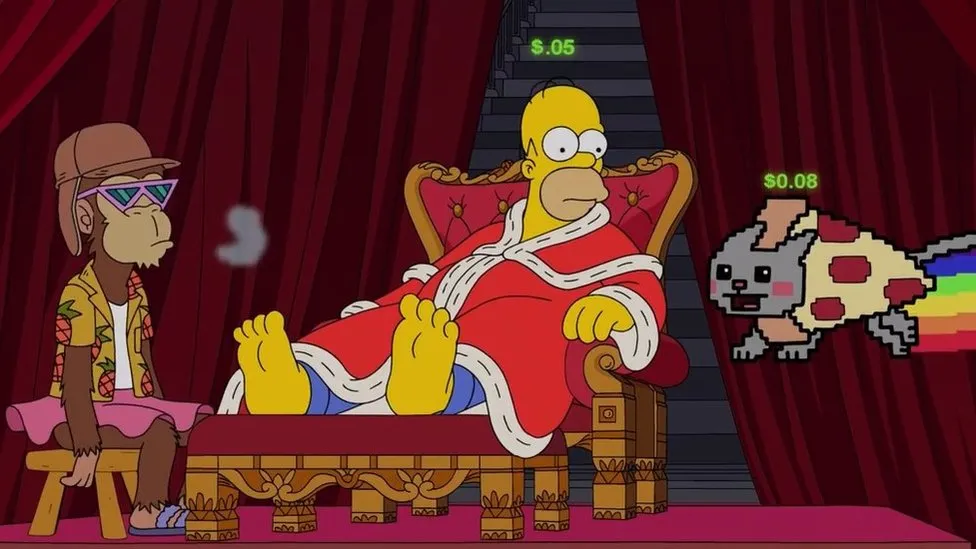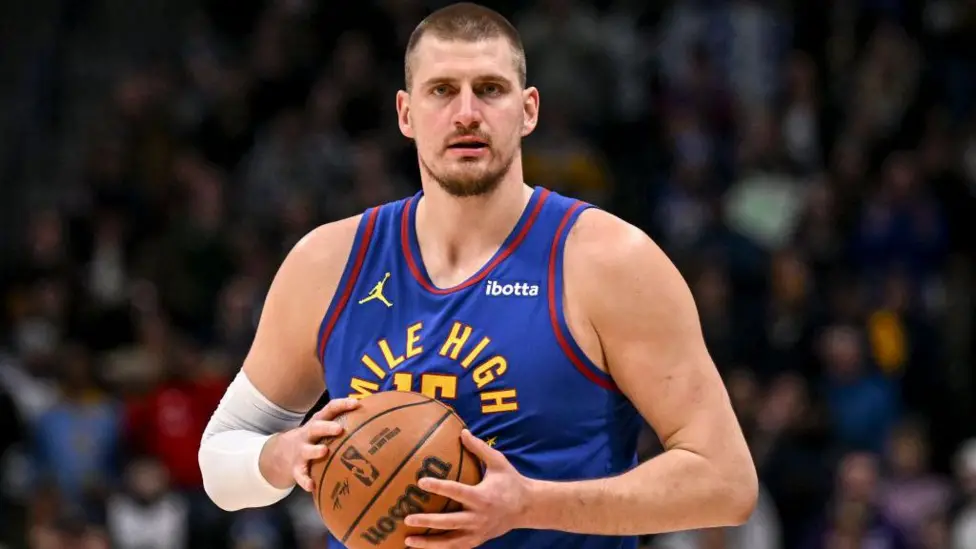Whatever happened to NFTs?
When Homer Simpson comes up with a get-rich-quick scheme it usually ends badly.

In the latest episode of The Simpsons the hapless dad turns his son Bart, and then himself, into NFTs to make millions.
It all goes wrong when Homer finds out from a floating pizza cat that "the NFT craze is over".
The episode has been widely applauded by NFT fans and sceptics alike for successfully poking fun at a side of the crypto world that exploded a couple of years ago but has now gone very quiet.
So is the floating pizza cat right, and are NFTs really dead?
Well analysis shows the once frenzied Non Fungible Token market declined to its lowest level recently, with October being dubbed "Floptober".
But some think there's hope.
NFTs are digital tokens of ownership usually bought with cryptocurrency.
They're often linked to images or videos, but owning an NFT does not normally mean the buyer gets the copyright of the picture. Anyone can view it online and even copy and save it, but only the buyer has the status of being the official owner of its token. Proof is etched onto the uneditable record of the blockchain - a giant spreadsheet of transactions published online.
According to researchers at Dapp Radar, the value of NFT transactions just hit the lowest point since the NFT market peaked.
Trading volume - the amount of money in sales across the whole industry - has fallen 89% from the beginning of 2022 to now.
Back then in the first quarter of 2022 it was $12.6bn (£10.4bn), and now in the third quarter of 2023 it's a mere $1.39bn.
And the industry is contracting. Last month Yuga Labs - the creators of the talismanic Bored Ape NFTs - announced an unspecified number of redundancies.
Bored Ape Yacht Club is one of its most famous series. It once had NFTs selling for millions of dollars, fuelled by celebrity buyers including talk show host Jimmy Fallon and media personality Paris Hilton.
Paris Hilton has not posted on X, formerly Twitter, about NFTs since October 2022, in spite of almost daily tweets in January and February 2022 to promote her collections.
According to the NFT Price Floor website, the floor price of Bored Ape NFTs (the value of the cheapest in the collection) peaked at the beginning of May 2022, then costing around $268,000 (144 Ethereum coins). Now it's dropped to $56,000.
Collector and artist Taylor Whitley from the US felt forced to sell six of his seven prized Bored Ape NFTs as the offers he was receiving were getting worse and worse.
"I haven't really wanted to sell, but the market is really bad, so it's the smart thing for me to do. I think the NFT market could even go lower," he tells the BBC.
Last month, Taylor sold his most valuable Bored Ape for $212,000 after previously turning down much better offers for it.
He could have got at least 10 times more for his NFTs if he'd have sold at the peak. It has stung him, but as an early investor he's still made incredible profits. His most recent sale is a 1,000 times return on his initial $200 investment.
For every Bored Ape NFT there are millions of other smaller brands and artists making up the industry.
Angie Taylor from Scotland was selling her NFT artwork for as much as $8,000 an item, but now she gets around $600.
She's had to go back to her pre-NFT job as a tutor part time.
"I'm still selling bits and pieces here and there, but I am having to do a day job as well. I can't make a living off this anymore with nothing else," she says.
But she always thought the bubble would burst.
"I kind of budgeted for this to happen, because I thought, this is a boom and bust type of situation," she says.
It's clearly a buyers market, and there are plenty of happy buyers out there making the most of the downturn.
Adam (known online as Little Fish) recently bagged himself a crypto punk artwork NFT for $663,000.
The full-time crypto investor from Europe acknowledges that it's a large amount of money but he thinks he got a bargain with his CryptoPunk #3609.
After all, a year ago its seller rejected an offer for $1.18m.
"The downturn is exactly why I bought it. People are desperate. In the winter time you can buy summer clothes for cheap," he says.
Adam believes that summer will come again to NFTs, and he will "enjoy it" when it does.
His analogy to seasonal changes parallels the current state of the cryptocurrency market.
Digital money like Bitcoin and Ethereum (ETH) have not recovered from various crashes in 2022 that saw the value of coins plummet and then stagnate in what many are calling a crypto winter.
There are recent signs of a thawing, with Bitcoin rising to $34,000 a coin, but the growth has stalled, and is nowhere near the $70,000 in late 2022.
Although NFTs are a different product they are built on the same blockchain technology as cryptocurrencies, and the wealth of many of the biggest NFT buyers is in lock-step with cryptocurrencies. When crypto is worth more - they have more to spend on NFTs.
The biggest ever NFT investor is Vignesh Sundaresan - known as MetaKovan.
His record-breaking $69m purchase of an NFT by American artist Beeple was one of the big catalysts that sent the market soaring in March 2021.
"It's still a long way to go before we can look back and see whether, you know, it was a good purchase or not," says Mr Sundaresan. "It was definitely a lot of money, but it wasn't a significant amount of my wealth."
Mr Sundaresan still believes that NFTs have a bright future as art collectibles, but he thinks the boom days are over.
"Everything in crypto happens very fast, and I think the next phase of NFTs won't be about the price. People who are speculating are taking a huge risk because it's not even like the supply is finite," he says.
Vignesh is critical of the industry that capitalised on the speculative craze and has left many people out of pocket.
"I've not seen any good sustainable businesses around NFTs," he says.
One NFT business that appears to be bucking the trend though is Pudgy Penguins - a brand that recently started selling soft toys based on its NFT characters.
Each toy sold provides royalties to the corresponding Pudgy Penguin NFT holder.
Allowing NFT owners to make money through intellectual property appears to be a trend that is potentially reviving interest in the products. Pudgy Penguins have maintained a floor price similar to its peak in January 2023, according to the NFT Floor Price website.
Other new ways buyers are being offered increased incentives are through membership to exclusive events, physical versions of NFTs and scrapping of artist royalties.
British NFT entrepreneur known as Pranksy thinks experimenting is key to a market recovery.
"I predict a small number of innovative individuals and brands will be able to spearhead mainstream adoption," he says.
He predicts that the market will rise once more, but admits it's unlikely to reach the levels of "pandemonium" previously seen.
-bbc






